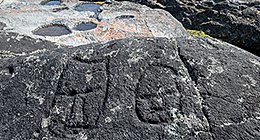 Petroglyphs at Qajartalik | |
| Alternative name | JhEv-1[2] |
|---|---|
| Location | Qikertaaluk Island, Nunavut, Canada |
| Coordinates | 61°19′53.6664″N 71°29′58.7184″W / 61.331574000°N 71.499644000°W[1] |
| Type | Petroglyph |
| History | |
| Cultures | Dorset culture |
Qajartalik (Inuktitut for "where there is a kayak") is a petroglyph site located on the Qajartalik peninsula of Qikertaaluk Island, Nunavut, approximately 40 km southeast of Kangiqsujuaq, Quebec.[2] The site consists of over 150 carvings of faces in soapstone.[2][3] It was created by the Dorset people, the culture who inhabited the Canadian eastern Arctic and Greenland beginning approximately 2,200 years ago before disappearing approximately 1,000 years ago, and who inhabited the region prior to the Thule Inuit who arrived approximately 800 years ago.[4][3] It is believed to be the northernmost rock art site in North America and is considered to be one of a kind.[3] The site is currently on Canada's tentative list of sites proposed for inscription on the UNESCO World Heritage List.[3][5][6]
- ^ Cite error: The named reference
UNESCOwas invoked but never defined (see the help page). - ^ a b c "Protection and development of the Qajartalik petroglyph site (JhEv-1)". Avataq Cultural Institute. Retrieved 17 May 2018.
- ^ a b c d "World heritage sites in Canada - Canada's Tentative List - Qajartalik, Nunavik". Parks Canada. Government of Canada. 23 January 2018. Retrieved 17 May 2018.
- ^ "Dorset culture". Encyclopaedia Britannica. Retrieved 3 June 2018.
- ^ "World heritage sites in Canada - Canada's Tentative List". Parks Canada. Government of Canada. 23 January 2018. Retrieved 17 May 2018.
- ^ "Canada puts forward 8 UNESCO recommendations". CBC News. 20 December 2017. Retrieved 17 May 2018.
